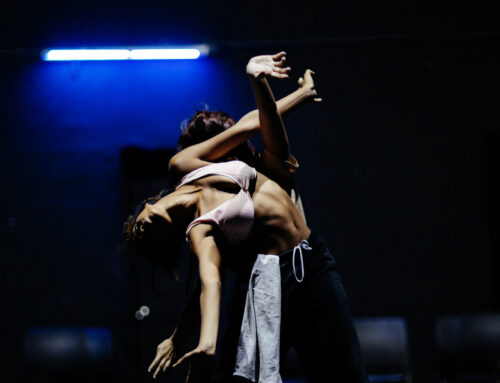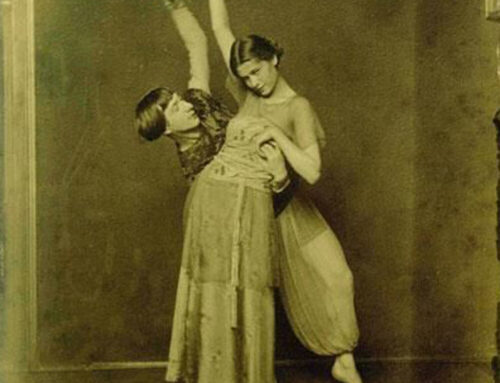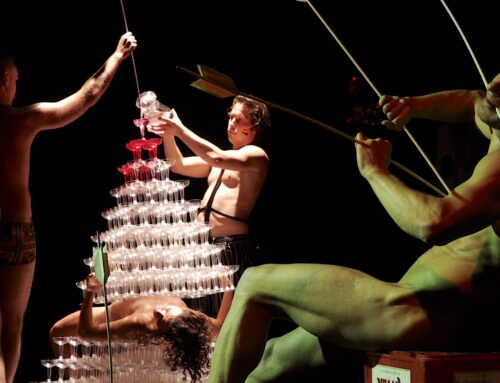schrit_tmacher festival 2024
Go to the basement to watch
A lot of light and two shadows – dance and other things on the screen, seen
by Melanie Suchy
A small collection of dance films can be seen in Heerlen until the end of the festival on 24 March, a selection from Cinedans. It costs nothing, you just have to keep to the opening hours of the cosy shop, in whose surprisingly huge underground the screens are set up, headphones within reach. The van de Velden van Dam bookshop, inconspicuous from the outside, is located opposite the theatre building in the pedestrian zone next to the large clay hole.
The basement is the opposite of a hole. Clean. There are works of art there too. The projections run in loops in booths separated by curtains. It’s a pleasure not to watch the films in small format on a laptop. This is more in keeping with the art that is dance film. But only two are super overall.
Lots of light…
The short, slow “Forming” is a great work. Eve McConnachie and Chloe Rosser from the UK (2022) shot it with members of the Scottish Ballet. The dance here is literally introverted. Two bare backs are pushed together, skin over spines and ribs, over muscles from shoulders to buttocks, arms clinging to them, only sometimes visible, or a leg grows upwards with now free toes that blink like eyes in the area. A belly breathes in and out, somewhere in the middle of the two bodies. The whole lump is cosy, perhaps protecting itself or mourning in company. But not in a corner, but in the middle of an idyllic room with a carpet and old furniture. Caroline Bridges’ camera casts a gently astonished gaze on the action.
“WO_MAN” by Dutch filmmaker Judith Knubben (2021), perhaps doesn’t want to fall into the trap of fuzzy movement. Posing is the new dancing anyway, as one sometimes gets the impression on all kinds of stages. The slow camera here charges the three protagonists standing and sitting around in elaborate dresses in a palatial ambience. What is it actually for? Perhaps it’s supposed to be a joke or an open question, complete with a glass ball that might just be a flummox. The leaflet talks about the “Three Graces” of mythology and the finally not “male gaze” on them. Somehow they seem unhappy. It was probably still Corona back then.
One of the two films projected in large format follows a man who gets into a leather suit from bed without underwear and then rides a motorbike, “Leather” by Thomas Bos and Erik Bos from 2018. It aims to depict a story or a fantasy of a frustrated man who likes to race, preferably at night on empty asphalt, and sometimes finds company between two other drivers, but harasses people on the pavement during the day. In the end, however, lots of people dance a bit of hip hop, all wearing clothes (specially designed without brand logos, by the way), and they sing Aaaaaaa. “If you point to the moon, people shouldn’t look at your finger,” says the spoken text that leads through “Leather”. Does the driver-speaker-dreamer think he is destined for greater things, for something beyond pointing fingers? Has he flown away now? Has he disappeared even more than in his leather clothing and under his helmet? The camera looks from above and climbs.
Imre and Marna van Opstal on the screen too…
Imre van Opstal and Marne van Opstal, dancer and dancer, sister and brother, also practise flying. In their film “Marsèll – Contrasts”, they float, held by ropes, strapped into leather corsage-like garments. Arms, legs and heads remain free, revealing the muscular bodies of the dancers. Andras Ladocsi’s camera is always close or very close, but itself quite fixed. The two flying dancers don’t move either, nor do they seem to want to. A little touch is enough. The three minutes seem strangely complacent. Unless you realise that this is a collaboration with a fashion label, Marsèll, and ignore the S&M feel.
The hit of the cellar is “Endurance”. Imre van Opstal shot the film in Israel with thirteen of her former colleagues from the Batsheva Dance Company in an abandoned industrial building. It is often used in dance films; in another abandoned building, Adi Halfin shot her unplanned, famous promotional video with and for the Batshevas in 2013: “Home Alone”. You can sense Imre van Opstal’s fascination with the clip; she just takes a lot more time. Which is a bit of a shame. There may also be a hint of Vandekeybus influence in her eleven and a half minutes. Because the dancers exhaust themselves, in running, in running dancing, in grasping, carrying, in handstands, in a state of surveillance even in sitting moments. They seem to be locked up, a corona memory. They are sweating, the camera shows the drops on their faces. A dancer is digging in the earth in the middle of the building, which is tiled everywhere; the film repeatedly shows the dancer squatting with her bare hands in the material, as if she is digging for an air or rescue hole. Or for the truth. In case this oppressive rustling around is a nightmare. Misha Kaminsky is the great director of photography, who translated the tension and the driven state into film.
Lots of shadows …long and longer…
Unfortunately, the critic lacked patience for “The Paper Ensemble #16” after watching the frenzy. It’s not only slow, but also long at 15:38 minutes. Which doesn’t speak against it. The Paper Ensemble, alias Jochem van Tol and Ibelisse Guardia Ferragutti, filmed with director Jiska Rickels, camera director Martijn van Broekhuizen and sound engineer Rik Meijer in the Paper Fabriek in Nijmegen. Four dancers, including choreographer Ferragutti, handle paper that has given up its flatness and become sculpture. For the women, they are fragile co-performers, whom they watch, whose breath and skin they listen to.
No button to fast-forward…
After all, “Romance” is really long at around 39 minutes. At some points you would like to fast-forward. But that’s not possible in a small cinema. The work by American Samantha Shay is rather pretentious, shot with an analogue camera, but she has cut a few beautiful moments out of what was probably hours of material and edited them into a film. It entices with terms on the package insert: Lichtburg rehearsal studio, fiction and reality, dance and documentary, “fruitful dialogue between generations”, immortal heritage, and the film also accompanies the transition of dancer Naomi Brito.
But nothing is accompanied here. You only notice that some dancers from the Wuppertal Dance Theatre, including just two of the “old ones”, Julie Shanahan and Julie Anne Stanzak, are happy to play along with the director’s loose staging, who gets very close to them with the camera.
Lots of faces in the film: women. A Julie with her hand on a wall in the cinema corridor finds small cracks, here, oh, there too, and the dancer and the director don’t miss out on the obvious joke about age in the editing suite.
The wonderful, serious Emily Castelli also wanders around and calls out a passage in Italian. It could be anger. Claudia Ortiz sits, speaks Brazilian-Portuguese and smiles. The text is from the short story “It was Romance” by American author and filmmaker Miranda July from 2012 and describes a kind of self-awareness workshop in which women learn to feel the air zone on their faces.
Finally, Naomi Brito in her stage dress moves a lot of air, delighting herself and the nearby camera with the swaying and looping, all the circles she can create on the spot with her body and arms. Because it is somehow cramped in the old cinema, where people are watching in the background and lots of clothes are hanging. Brito plays with repeated name-calling, as celebrated in some Bausch pieces. “Sam!”, “Sam!”, “Sam!”. In between, she says incredibly brutal sentences in English. There are only two or three, about her childhood. She smiles broadly. This is the most pina-bouche moment of the whole thing. Honouring beauty and not trusting it, the airy cloth over the memory of pain.













